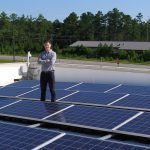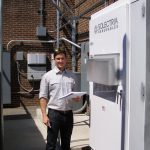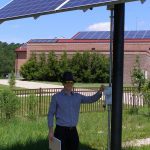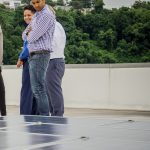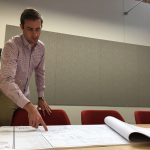This summer, four Presidio Graduate School students embarked on a mission to drive energy and sustainability change in organizations across the country. Alex Grande, Anuraag Jhawar, Doug Perry, and Robert Bartolucci all served as fellows in Environmental Defense Fund’s prestigious EDF Climate Corps fellowship program. While their experiences differed in size and scope, they intersected in the transformations created.
Below is a summary of what each student worked on during the summer:
Alex Grande
Host Organization: U.S. Army
“The reason I chose to come to PGS was that I wanted to gain the skills to be able to improve the social, environmental and commercial impact of any situation that I came into. This past summer as a Climate Corp Fellow, in a part of the country I’d never been to, in a sector I’d never worked in, the PGS curriculum was integral to my success.”
 Goals: The Department of Defense and the U.S. Army has become increasingly interested in resilient operations due to federal mandates but also damaging weather events, equipment failures, and cyber-attacks. Army leaders understand that energy security is critical to the effectiveness of the mission. To mitigate against potential power outages, U.S. Army Garrison Fort Bragg enlisted Alex to study how microgrids could ensure security and resilience.
Goals: The Department of Defense and the U.S. Army has become increasingly interested in resilient operations due to federal mandates but also damaging weather events, equipment failures, and cyber-attacks. Army leaders understand that energy security is critical to the effectiveness of the mission. To mitigate against potential power outages, U.S. Army Garrison Fort Bragg enlisted Alex to study how microgrids could ensure security and resilience.
Solutions: Alex approached the challenge using a three-part process:
- Identify goals and criteria for energy security and resilience projects. After reviewing several reports, analyses, and funding programs, Alex identified the Energy Resilience & Conservation Investment Program as the most appropriate source of project funding.
- Select locations and products for microgrids. Alex evaluated more than 100 facilities and determined that five were ideal for two separate microgrid designs. He also reviewed products and vendors to determine appropriate equipment recommendations.
- Assign a dollar figure to resiliency. Leveraged the Customer Damage Function methodology to determine a value for energy security.
Potential Impact: Using carport PV systems, battery storage, and cyber-secure control systems, one of the design locations was feasible for a microgrid. This system would offset 108 metric tons of CO2 emissions and mitigate against any productivity losses due to power outages.
A survey was developed to calculate the value of energy security using the CDF methodology. Fort Bragg can leverage this survey for each new resiliency project going forward. This will allow them to identify further savings opportunities.
Anuraag Jhawar
Host Organization: PGIM, Inc.
“The EDF ClimateCorps fellowship was a great way to put my MBA skills to work at a real organization while allowing me the experience to live in a new city and build a lifetime network of likeminded sustainability professionals!”
 Goals: For any real estate portfolio, sustainability is a critical piece of asset security, performance, disclosure, and transparency. That’s why PGIM Real Estate wanted to improve upon its sustainability reporting and evaluate and implement energy efficiency projects at a portfolio-level, rather than the current fragmented asset-by-asset approach. Anuraag was brought onboard to help overcome three challenges: evaluate impacts on investor returns, engage external stakeholders and improve sustainability disclosure.
Goals: For any real estate portfolio, sustainability is a critical piece of asset security, performance, disclosure, and transparency. That’s why PGIM Real Estate wanted to improve upon its sustainability reporting and evaluate and implement energy efficiency projects at a portfolio-level, rather than the current fragmented asset-by-asset approach. Anuraag was brought onboard to help overcome three challenges: evaluate impacts on investor returns, engage external stakeholders and improve sustainability disclosure.
Solutions: Anuraag assisted PGIM Real Estate in advancing its sustainability programs by focusing on three separate initiatives:
- Sustainability Reporting – Anuraag assessed PGIM Real Estate’s current reporting process to the Global Real Estate Sustainability Benchmark (GRESB). To improve stakeholder engagement, he recommended broader use and adoption of Measurabl, a new environmental management tool for streamlining data collection.
- Electric Vehicle Charging – Anuraag created a program for asset managers and property managers to budget for EV chargers. Included was a survey to assess demand, financial modeling tools, and a pre-qualification checklist to determine if EV charging is a good fit for an asset.
- PACE Financing – Anuraag evaluated how and where PACE financing could be used to fund energy efficiency projects, how much of the cost could be passed on to tenants, and what the net improvement to cash flow would be.
Potential Impact: Based on these improvements, PGIM Real Estate’s sustainability team is better positioned to shorten the time and effort required to submit the GRESB survey, improve its scores for each fund, and identify next steps to improving sustainability disclosure, such as issuing GRI-aligned reports. Anuraag’s work gives asset managers a way to budget for the installation of EV chargers, which they hope to increase by 100% over the next fiscal year. By using PACE financing, PGIM Real Estate can also make the case to implement energy efficiency projects that otherwise would not have been considered. And, taking a portfolio-based approach to energy efficiency may indirectly improve investor returns for the fund.
Doug Perry
Host Organization: Grocery Outlet
“The EDF experience gave me the opportunity to apply my Presidio education in systems thinking to help Grocery Outlet advance its energy efficiency goals and create a more integrated sustainability strategy. Already the network has proved valuable and I expect to stay connected for my entire career.”
 Goals: Grocery Outlet wanted to accelerate its energy efficiency and cost savings initiatives at its nearly 300 stores across the west coast, build a sustainability strategy framework, and communicate its work in energy efficiency to stakeholders. Doug was brought in to help evaluate and execute the installation of Stem and Viking Cold Storage systems at southern California stores, create a sustainability mission statement and help create a customer focused marketing campaign.
Goals: Grocery Outlet wanted to accelerate its energy efficiency and cost savings initiatives at its nearly 300 stores across the west coast, build a sustainability strategy framework, and communicate its work in energy efficiency to stakeholders. Doug was brought in to help evaluate and execute the installation of Stem and Viking Cold Storage systems at southern California stores, create a sustainability mission statement and help create a customer focused marketing campaign.
Solutions: Working on the Construction team, Doug worked with the legal team to negotiate a template contract for Grocery Outlet’s independent store operators to use with Stem and coordinated with Stem to create a customized analysis for each store, discussing the potential savings with the store operators. After learning about the organization’s strategy and mission, he worked with senior leadership to create a sustainability statement to help guide and communicate their integrated strategy for the future. Before creating the ultimate deliverable of in-store signage educating customers about the energy efficiency investments the company had been making to drive down costs, Doug needed to gather and analyze data about each store and each investment in lighting, HVAC, and refrigeration retrofit/install. Working with vendors and internal teams, he quantified the environmental and economic impact that had already been made, as well as identified opportunities for future investments and savings across the portfolio of stores. Using the data and leveraging the marketing team’s expertise, Grocery Outlet created signage for stores that can boast the energy efficient features.
Potential Impact: The Stem and Viking Cold Storage installations shift energy demand to off-peak hours, saving each store an average of $2,500/year. The initiatives already in place save an estimated 27.89 million kilowatt-hours/year and $3.38 million/year across all 300 stores. Recommendations include expanding the Stem installations, implementing tracking and goal setting using Energy Star, GreenChill, and an integrated energy management plan so the company can better manage their energy use and cash flow in the future.
Robert Bartolucci
Host Organization: GUESS? Inc.
“Being an EDF Climate Corps fellow was a valuable experience in navigating the challenges of influencing executives to make short-term sacrifices, in pursuit of a long-term vision.”
 Goals: Guess, a global clothing, and fashion accessory retailer enlisted Robert to reduce energy consumption in 300 of its stores across the United States and Canada. Since each of these stores was still being lit by incandescent, halogen, and fluorescent lamps, senior leaders at Guess requested a portfolio-wide LED retrofit investment analysis. With total electricity consumption of 38 million kilowatt-hours in these stores annually at a cost of $5.4 million, there existed tremendous opportunity to reduce the company’s carbon footprint in a financially sound manner.
Goals: Guess, a global clothing, and fashion accessory retailer enlisted Robert to reduce energy consumption in 300 of its stores across the United States and Canada. Since each of these stores was still being lit by incandescent, halogen, and fluorescent lamps, senior leaders at Guess requested a portfolio-wide LED retrofit investment analysis. With total electricity consumption of 38 million kilowatt-hours in these stores annually at a cost of $5.4 million, there existed tremendous opportunity to reduce the company’s carbon footprint in a financially sound manner.
Solutions: After creating a database of information for each store in scope, including electricity use and cost, operational hours, lighting fixture schedules, location-based emissions, and utility-specific rebates, Robert prioritized a list of the most viable retrofit projects. The challenge of this approach was the uniqueness of each store, from an energy and physical layout perspective. Through consultation with Guess’ retail development team and on-site visits, Robert executed an accurate and comprehensive analysis workbook, detailing the NPV and GHG savings for each planned retrofit. As Robert discovered, 87 of the 300 stores in scope were not good candidates for LED retrofits due to negative NPV’s. Also, Robert made a recommendation to halt the use of a certain standardly-used LED fixture, due to its long payback period and increase in total carbon dioxide emissions.
Potential Impact: Should Guess proceed with the recommended LED retrofits, the organization could reduce total electricity consumption by 9.1 million kilowatt-hours annually at a savings of $1.5 million in operational costs. On the whole, this portfolio of LED-ready candidate stores offers the potential to decrease carbon dioxide emissions by 4,189 metric tons annually with an average project payback of 2.7 years. At the end of his fellowship, Robert presented his findings to Guess’ retail development and internal audit teams. With this project, Guess is better equipped to make investments towards reducing overall carbon emissions.



